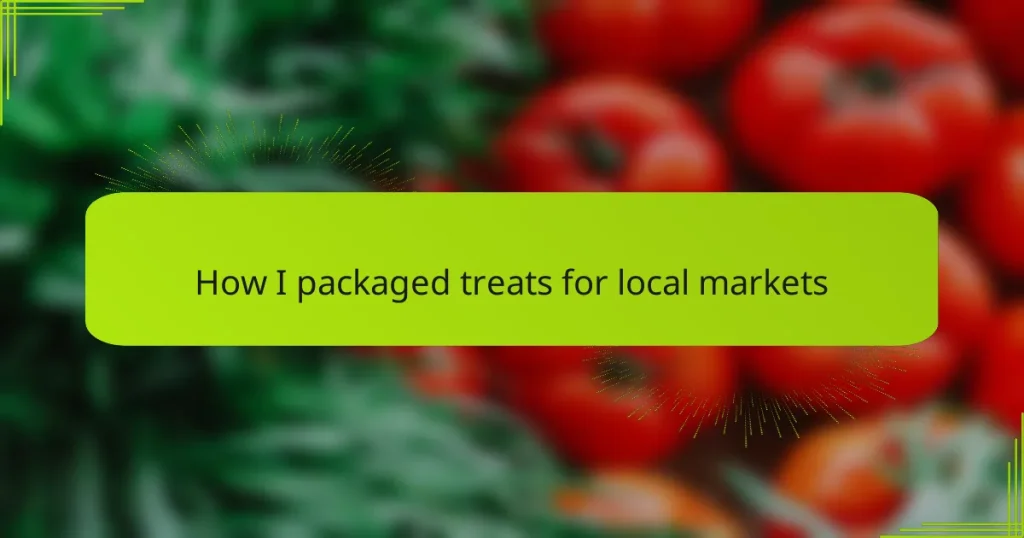Key takeaways
- Choosing the right packaging materials is critical for preserving the freshness and texture of desserts, with considerations for moisture control and aesthetics.
- Effective packaging not only protects treats during transport but also enhances the visual appeal, creating a positive first impression for customers.
- Clear labeling that includes ingredient lists and allergen warnings builds customer trust and professionalism.
- Testing packaging under real conditions is essential to avoid issues like melting or difficulty opening, ensuring a pleasant customer experience.

Understanding dessert packaging basics
When I first started packaging my homemade treats, I realized quickly that dessert packaging is more than just wrapping—it’s about protecting the delicate textures and flavors inside. Have you ever bitten into a cake only to find it dry or stale because it wasn’t stored properly? That’s exactly what packaging aims to prevent.
I learned that choosing the right materials is key; for instance, some of my fruity tarts did better with a breathable wrap to prevent sogginess, while my cookies thrived in airtight containers. It’s fascinating how small details, like sealing and ventilation, can make all the difference in keeping freshness intact.
Thinking about presentation, I found that packaging also sets the first impression before anyone even tastes the dessert. Isn’t it amazing how a simple, neat box or creative label can make people feel excited to try what’s inside? Packaging is truly the silent ambassador of your delicious creations.

Choosing the right packaging materials
Choosing the right packaging materials felt like a puzzle at first, but I quickly saw it as part art, part science. For example, when I wrapped my brownies in wax paper, they stayed moist without getting sticky—a small change that delighted my customers.
I often ask myself, how do I balance aesthetics with practicality? Sometimes, a sturdy cardboard box is perfect for fragile pastries, keeping everything safe while still looking inviting on the market table.
One thing I learned the hard way was that using plastic wrap might seem convenient, but it can trap moisture and ruin a flaky crust. Switching to parchment or using vented containers made a noticeable difference in how fresh my treats stayed by the time they reached buyers.

Designing appealing treat packaging
Designing packaging that truly catches the eye was a challenge I welcomed enthusiastically. I remember experimenting with colors and fonts, wondering, “Will this label make someone pause and smile?” It’s amazing how a well-chosen color scheme or a handwritten tag can create an instant connection to the treat inside.
Sometimes I think about the story my packaging tells. Does it feel homemade and cozy, or sleek and modern? I settled on a rustic, handmade vibe with kraft paper and twine because it reflects the warmth I want customers to feel when biting into my desserts. That little touch made a big difference in how people responded.
One time, I packaged a batch of mini cheesecakes in clear boxes with delicate ribbon, and customers kept commenting on how elegant they looked. This taught me that even simple upgrades, like adding a ribbon or a custom sticker, can elevate your treats and make buyers feel they’re getting something special. Have you ever noticed how small details like that change your perception of a product?

Preparing treats for local markets
When I prepare my treats for local markets, I always think about the journey they’re about to take. Will the brownies stay moist on a bumpy ride? Can the delicate tarts survive being stacked? Packaging isn’t just about looks here—it has to protect each bite until the customer unwraps it.
I’ve found that adjusting portion sizes helps a lot. Smaller, individual servings not only fit better in market baskets but also invite tasting without commitment. It’s rewarding to see people smile when they realize they can enjoy a sweet treat guilt-free, and that all started with thoughtful packaging choices.
Have you ever noticed how important ease of handling is at markets? I once packaged cookies in a bulky box, and customers struggled to carry them around. Learning from that, I switched to lightweight, windowed bags that show off the goodies inside while making it simple to grab and go. It’s these little tweaks that make all the difference when selling in busy local spots.

Packaging techniques for freshness
Keeping freshness in mind, I quickly realized that airtight sealing was a game-changer for my treats. Have you ever bitten into a cookie that’s lost its crispness? That’s the kind of disappointment I wanted to avoid. Using resealable bags or tins became my go-to for locking in that just-baked taste.
I also discovered that layering can protect delicate desserts. For example, placing parchment paper between stacked cookies stopped them from sticking together and preserved their texture. Isn’t it interesting how something as simple as a sheet of paper can extend freshness?
Temperature control played a big role in my packing strategy too. I started adding ice packs to boxes when delivering cream-filled pastries, which helped keep them cool without sogginess. It felt like giving my desserts a cozy little fridge ride until they reached their new homes.

Labeling and legal considerations
Labeling your treats for local markets isn’t just about slapping on a pretty sticker—it’s about knowing what information you’re legally required to share. When I first started, I underestimated how important ingredient lists and allergen warnings were. Have you ever bought a treat only to realize too late it contained nuts you’re allergic to? That kind of oversight can harm your customers and your reputation.
Navigating local food laws felt overwhelming in the beginning. I learned that many places require you to include your business name, address, and sometimes even a best-before date. Including nutritional information can seem daunting, but even a simple note about allergens or storage instructions can make a huge difference for buyer trust.
One thing that surprised me was how properly labeling gave my treats a more professional feel. It made me proud to display my desserts confidently at the market, knowing I was playing by the rules and taking care of my customers. Have you thought about how a clear, honest label might change the way people perceive your goodies?

Tips from my packaging experience
One tip I’ve learned is to always test your packaging under real conditions before the market day. I remember once bringing a batch of chocolate-dipped cookies in beautifully sealed boxes, only to find by midday that the chocolates had melted because the container wasn’t insulated enough. That experience taught me how crucial it is to consider factors like heat and handling, not just looks.
Another thing I noticed from my experience is the power of simplicity. Fancy packaging feels great, but if it’s hard to open or too bulky, customers might get frustrated and skip buying altogether. Have you ever struggled to peel off a stubborn wrapper when your sweet tooth was calling? Making packaging user-friendly has saved me from that pitfall and kept buyers coming back.
Finally, don’t overlook the emotional connection packaging can build. I once added a small, handwritten thank-you note inside each treat’s box just to say “enjoy your dessert!” The smiles and repeat customers that followed convinced me that packaging is more than protection—it’s a chance to share a little warmth and personality with every bite.




